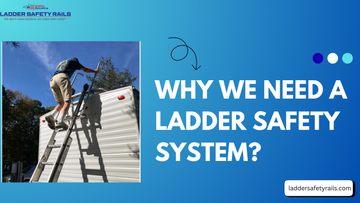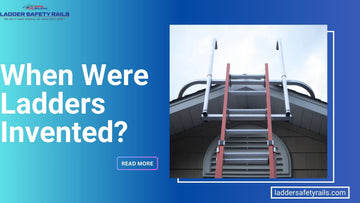
When it comes to tackling home or commercial maintenance tasks at height, knowing how to use an extension ladder is important. If you're reaching your roof, trimming trees, or accessing second-story windows, the right extension ladder can make the job easier and much safer. But here's the thing misusing one can lead to serious injuries. Understanding proper technique and choosing the right ladder safety devices is your first step to working smarter, not riskier.
This guide will teach you everything you need to know about extension ladder safety, including ladder positioning techniques, ladder setup instructions, and tips for using extension ladder safety attachments.
If you’ve ever wondered about extension ladder width, or which size to use, from a 16 ft extension ladder to a 40 ft extension ladder, you’re in the right place.
Choose the Right Extension Ladder Size
Picking the right size ladder isn’t just about reach; it’s about safety. Selecting the appropriate extension ladder ensures you’re not overextending yourself. A 16 ft extension ladder might be perfect for single-story homes, while a 20 ft extension ladder or 24 ft extension ladder might be good for most two-story projects. For larger commercial needs, a 40 ft extension ladder gets the job done.
Use an extension ladder size chart to determine your required ladder extension based on the height you need to reach and the angle at which the ladder will rest. The usable length is often 3–4 feet shorter than the full length due to overlap between sections. You’ll also want to consider extension ladder width, as wider ladders often provide more stability.
If mobility is key, go for a lightweight extension ladder, usually made from aluminum. These aluminum extension ladders are durable and easy to transport, perfect for professionals and DIYers alike.
Set Up Your Ladder the Right Way

Setting up a ladder properly might seem simple, but it’s one of the biggest factors in preventing accidents. To start, follow basic ladder setup instructions. Always place your extension ladder on a flat, stable surface. The base should be positioned using the correct ladder angle rule: set the ladder base 1 foot out for every 4 feet of vertical height. This gives you the ideal working angle of 75 degrees.
This rule is important to extension ladder safety and reduces the chances of tipping backward. If you’re wondering what angle should an extension ladder be placed at, this is your answer. Also, remember to extend the ladder at least 3 feet above the roofline if you’re accessing a rooftop.
Need to know how to set up an extension ladder on uneven ground? Use ladder safety accessories like levelers, cleats, or anti-slip feet. Don’t forget that an unstable ladder is a safety hazard, so securing the base is non-negotiable.
Use an Extension Ladder Stabilizer
If you’ve used a ladder to clean gutters, wash windows, or paint trim, you already know how shaky it can feel. That's where an extension ladder stabilizer comes in. These add-ons are among the most valuable extension ladder safety attachments out there, providing lateral stability and minimizing bounce or sway.
Want to know how to use an extension ladder with gutters? Start by installing a stabilizer bar that prevents the ladder from leaning directly on fragile gutter material. The stabilizer distributes weight across a larger area and helps keep your ladder secure.
For additional ladder safety system upgrades, consider using stabilizers with rubber bumpers or stand-off arms. These are especially useful when using a 24 ft extension ladder or longer, where added height means more movement.
Read more blog: When Were Ladders Invented?
Maintain Three Points of Contact
If you take only one extension ladder safety tip from this article, let it be this: always maintain three points of contact. That means two hands and one foot, or two feet and one hand, must be in contact with the ladder at all times.
This tip applies whether you’re using a 16 ft extension ladder or a 40 ft extension ladder. It’s a fundamental part of ladder safety rules and a key part of any step-by-step guide to using an extension ladder.
Wondering how do you safely use an extension ladder? Don’t carry tools in your hands as you climb. Instead, use a tool belt or rope and pulley system. This frees up your hands and helps keep your center of gravity stable, which is essential when working at height.
Secure the Ladder Before Climbing
Even with the best setup, failing to secure your ladder is a common cause of accidents. Securing an extension ladder involves anchoring it at the top and/or bottom to prevent sliding or tipping. Use tie-offs, ladder hooks, or ladder safety devices like base stabilizers.
If you're working alone, ask yourself: Do you need someone to hold an extension ladder? The answer is often yes when you're dealing with a tall or aluminum extension ladder that may shift on slick surfaces.
Another vital consideration is extension ladder height adjustment. Always ensure the rung locks are properly engaged before climbing. This ensures structural integrity and prevents sudden collapses or missteps.
Climb Safely and Smartly
Let’s talk about climbing. How to climb an extension ladder safely is something every user should master. Face the ladder while ascending, grip the side rails, and wear shoes with non-slip soles.
Also, avoid climbing during windy, rainy, or icy conditions. Weather plays a huge role in extension ladder safety, if you’re using a lightweight extension ladder, which can be more vulnerable to gusts.
Need a refresher? Watch a how to use an extension ladder video online to see these techniques in action. Real-time visuals can reinforce best practices in a way that text alone sometimes can't.
Avoid Common Mistakes

Despite all the gear and guidance, human error can still cause ladder-related injuries. Some common mistakes when using an extension ladder include:
-
Setting the ladder at the wrong angle.
-
Not locking the extension mechanisms.
-
Using a ladder that’s too short (forcing overreach).
-
Ignoring visible damage like bent rungs or rusted locks.
Want the best way to secure an extension ladder? Use both mechanical stabilizers and a spotter. If possible, invest in a ladder safety extension that improves upper-wall contact for better load distribution.
Think of these tips as your personal checklist for every ladder job.
Store and Maintain Your Ladder
After the job’s done, don’t just toss your ladder in the garage. Knowing how to store an extension ladder properly is part of long-term extension ladder maintenance.
-
Hang it horizontally on wall hooks to prevent warping.
-
Keep it indoors to avoid corrosion if you own an aluminum extension ladder.
-
Check the rungs, locking mechanisms, and feet regularly for wear or damage.
Routine inspections go a long way in keeping your ladder functional and safe for years to come. Remember, the next time you’re googling how to extend a ladder properly, you’ll be glad you kept it in tip-top shape.
Final Thoughts:
By now, you should feel confident about how to use an extension ladder, and more importantly, how to do it safely. From choosing between a 20 ft extension ladder and a 24 ft extension ladder, to understanding ladder safety rules and using the right extension ladder safety attachments, you’ve got the full playbook.
Ready to enhance your ladder setup? Shop Ladder Safety Rails at your trusted supplier to ensure maximum stability and protection on every climb.
FAQ:
Q: How to safely use an extension ladder?
To safely use an extension ladder, start with proper setup following the 4:1 angle rule, use stabilizers, and always maintain three points of contact. Accessories like ladder safety extensions help secure the ladder during use.
Q: How to properly use an extension ladder?
Proper usage includes selecting the correct extension ladder size, setting it up on even ground, securing it with stabilizers, and climbing with care. This is where ladder positioning techniques and safety gear make a big difference.
Q: How to use an extension ladder with gutters?
Use an extension ladder stabilizer to avoid placing pressure directly on the gutters. Extend the ladder 3 feet above the roofline for added safety and maintain a safe working angle.
Q: How to use an extension ladder video?
Search YouTube for how to use an extension ladder tutorials. These videos demonstrate everything from setup and extension to positioning and safe climbing practices.
Q: How to use an extension ladder with a stabilizer?
Attach the stabilizer according to the manufacturer’s instructions. This creates a wider point of contact and enhances extension ladder safety when working on uneven or delicate surfaces like siding or gutters.
Read more related blog:




